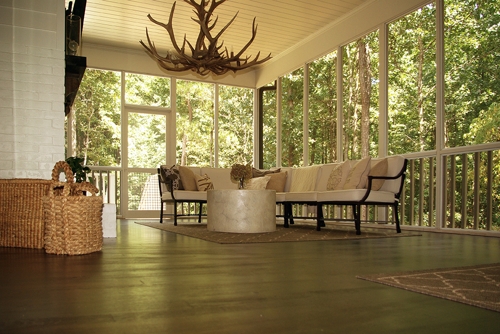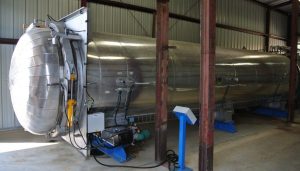What is Thermally Modified Lumber?
Date: May, 2019

By Hal Mitchell, President, Atlanta Hardwood Corporation
It’s not often that we see a revolutionary new process in the lumber industry. New developments in thermal modification may well be one of these processes.
The idea is relatively simple: heat lumber to above 320° F in a low-oxygen atmosphere to produce chemical and physical changes in the wood’s cellular structure. The heat treatment results in improved durability and increased dimensional stability. The improved stability allows for a superior flooring performance where minimizing movement is important.
Thermally modified lumber (TML) has been widely accepted in Europe for decades and is finally making its way to North American industrial production. While the treatment concept is relatively simple, the technology is complex and costly. Also, there is little history of treatment schedules (recipes) for most North American species. Each species and thickness requires a unique treatment temperature and duration to achieve proper modification levels. Entry barriers, lengthy learning curves, and lack of production standardization have kept American production relatively low.
There are two basic treatment systems: open and closed. Open systems use atmospheric pressure or a vacuum during treatment, while closed systems operate under high pressure. Open systems require drying the wood to nearly zero percent moisture content during the treatment phase to reach temperatures above 212° F. Open systems comprise most of the worldwide production. Closed systems require high pressure often above 100 psi. This allows for the material to retain moisture during treatment, which results in less shrinkage stress and lower degrade. Closed system cycle times are much faster, but the throughput is typically lower. Additionally, closed systems may not require as much heat to provide sufficient modification levels.
The treatment process uses only heat and steam, so it is completely “green” with no introduced chemicals. During treatment, the wood undergoes both physical and chemical changes. Some sugars are “burned” away (decomposed), leading to a reduction in food source for decay fungi. Wood color is changed through its cross-section to a darker color resembling walnut or tropical imports. The energy input also develops a much more stable product. Bond sites on cell walls provide for dimensional movement in wood as they attract and release water molecules with environmental changes.
One theory on the increased dimensional stability of thermally modified woods is that during the thermal modification process, enough energy is introduced to crosslink these sites and limit the woods ability to absorb water. Thermal treatment significantly reduces the available bond sites for water molecules, so dimensional stability is improved. Research indicates that dimensional movements due to moisture uptake can be reduced 50-90 percent (Jamsa and Viitaniemi, 2001).

Thermal modification reduces many of the mechanical properties of wood. Increased brittleness and decreased strength occur with bending strength reductions of 30 percent or more depending on treatment intensity (Kubojima et al., 2000). Hardness decrease is relatively limited at approximately 3 percent, but can vary tremendously by treatment levels. A “burnt” odor is produced during the process and can remain present in the wood. The unpleasant smell results largely from furfural production and can be limited if a vacuum is pulled during the final production phase. The odor will dissipate over time and can be negated once sealed.
The stability enhancement can allow wood products to be used in new and improved applications including flooring. Treatment will limit the dimensional change of wide plank flooring. This idea is often used by European plank flooring manufacturers when decay is not an issue as the dimensional stability can be greatly enhanced without reaching full modification and color change. Where stability is extremely important, such as basement or porch flooring, thermal modification will provide significant performance improvement. Of course, no wood product is 100 percent stable, so often micro-beveled edges are used in areas subject to large humidity changes. Moisture content is lowered in treated wood. Typically, thermally modified wood is dried to 4.5-6 percent. Lower moisture content is a good attribute when lightweight installation is needed such as garage doors and shutters.
Current markets, particularly in Europe, consist heavily of three products: cladding, decking, and flooring. Softwoods comprise the majority of the worldwide production, but hardwoods are gaining popularity. Historically, untreated American hardwoods could not be used in cladding or decking, but with the thermal treatment process, they perform well.
TML characteristics are similar to the untreated species characteristics. After treatment, finish quality often improves, grain patterns remain the same, and the sapwood and heartwood often become difficult to distinguish. Increased brittleness requires sharp tooling and often eased or beveled edges are preferred due to chipping. The material glues well with non-water based adhesives.
Stainless steel fasteners are often necessary for installation. Flooring installation requires extra caution with the degree of brittleness. Brittleness is dependent on treatment level and species, tongue breakage is a concern.
Finishing typically requires oil-based products, but there are specially formulated water-based products that are becoming popular as well. The wood oxidizes (grays) quickly to a silver patina unless treated with a UV inhibitor. While the finish life is improved due to increased wood stability, the UV inhibitors will typically need to be reapplied annually in areas with direct UV contact.
North America currently lacks the support of a thermally modified wood industry association to promote increased production and utilization of thermally modified wood; however, the American Wood Production Association (AWPA) is working to provide standardization. To ensure that TML manufacturers are properly treating their material and not overstating the performance properties, there will need to be a collaborative effort to provide user standards. Mechanical and durability tests will need to be performed on the North American species; some of this work is currently underway by the University of Minnesota Duluth at the Natural Resources Research Institute (NRRI). Product quality can vary due to initial lumber quality, treatment recipes, and kiln types. It will be imperative that specifiers, installers, and consumers are educated on proper installation techniques and performance expectations to prevent market failure and “overselling” of performance capabilities.
We have a unique opportunity to create new and improved uses for North American lumber through the thermal modification process. This opportunity is rare in our industry, and we must be diligent to ensure manufacturers and customers have realistic expectations of the TML.
Hal Mitchell is President of Atlanta Hardwood Corporation based in Mableton, Georgia. He has been with the AHC Hardwood Group since 1999 and has a Master of Science Degree in Forest Products Marketing and Management from Virginia Tech. AHC operates a closed-system thermal modification plant in Cleveland, Georgia. He can be reached at 800-476-5393 / 706-865-3166 or via email. To learn more about Atlanta Hardwood, visit hardwoodweb.com.
Citations:
Jamsa, S., Viitaniemi P., 2001. Heat Treatment of Wood Better Durability Without Chemicals. In: Rapp, A.O., Review On Heat Treatments of Wood. Cost Action E22. Proceedings of Special Seminar, Antibes, France, pp. 17-21.Kubojima, Y., Okano, T., Ohta, M., 2000. Bending Strength and Toughness of Heat-Treated Wood. Journal of Wood Science 46, pp. 8-15.


.svg)
